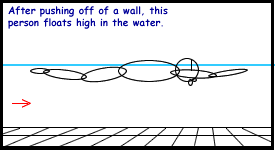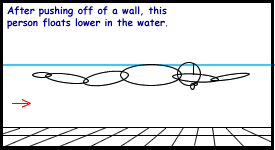Swim Physics
There is a lot of material out there dedicated to helping you swim faster, smarter, better. If you’ve faced your fear, learned your swim basics and are ready for improved performance, bravo!
You’ll be off to other horizons, beyond what I can offer her at RelaxnSwim.com.
But not so fast, my speedy friend! As you’ve been hearing over and over, your basics start with relaxing and not fighting the water. Smart, smart, smart.
Next you’ll learn to position your body to reduce the dreaded drag, aka “resistance.” Who’s going to work harder than they need to? Not you, smarty.
You’ll build upon these facts throughout your swim career, adjusting your swimming style as you better understand how water really works.
Article about swim physics
Total Immersion has a helpful article: Swim Like a Fish: A Science Report
http://archive.totalimmersion.net/2003 articles/may/science.html
What is buoyancy?
As you float, your weight presses down into the water; the water presses back, pushing you up.
When you get into the pool, your body displaces a volume of water (the “hole” in the water that your body fits into). As long as the water your body displaces weighs more than you do, you float.
This is basically Archimedes’ Principal.
You weigh less than the water you’re in, because your lungs are full of air, like a balloon, and like a balloon, the air in your lungs lifts you to the surface naturally.
Why don’t we float alike?

We each float in the water at our own natural level.

Different factors contribute to how high — or low — in the water we float.
You can swim no matter how you float.
First, your body type has a lot to do with your buoyancy. Fat floats, as you’ve probably heard, while your bones and muscles, denser than fat, are not as willing to float.
Also, the relative size of your lungs to the rest of your body determines how high in the water your body will float.
Second, the density of the water is a factor. Saltier water weighs more per unit of volume, so you will float higher in saltier water (the Red Sea, for instance) than you would in fresh water.
Finally, there is a curious phenomenon of apparently greater buoyancy — for some people — in deep water.
According to Melon Dash of the Transpersonal Swimming Institute,
You can be buoyant but not feel buoyant.
Your buoyancy does not change between the shallow and the deep. Your feeling of buoyancy may change. “Feeling buoyancy in water is all about ‘presence’ in one’s body.
Presence — feeling while swimming — is most available when a swimmer is not distracted by the pool bottom, or anything else. “The pool bottom is closer in the shallow end and farther away at the deep end.
Because it’s so close in the shallow end and you know you can use it any time, it may also be a distraction: some of your awareness, that is, some of your attention or presence is on the bottom. “When this distraction is not there in the deep end due to the fact that we can’t use the bottom there, people often feel more buoyant in the deep: their awareness is all at the surface rather than part of their awareness being at the bottom, as in the shallow.”
A factor you CAN control is how relaxed you are. Tense muscles often keep your body a bit lower in the water, since many people breathe more shallowly and rapidly when tense (hence less air in the lungs for floating).
Did you ever play the “think heavy” game as a kid? You are harder to lift if you imagined yourself to be as heavy as a piano, easier to lift up if you pretended to be a balloon.
Relax and reduce drag in the water to swim really smart.
Again, we each have our natural level of buoyancy. And then, there are those few who don’t float at all (for various reasons).
But no matter how low in the water you float or glide or swim, it has nothing to do with ultimately learning to swim. Period. You’ll adjust your stroke, roll your face out a bit more to get your air, and swim.
Test your buoyancy
You’ll need a pool, you’ll need to know how to tread water in the deep end, a buddy and as always, a lifeguard.
- Your buddy can sit on the pool ledge next to you, at the deep end. The lifeguard will also be close by.
- Have your goggles on.
- Climb down the pool ladder’s steps, facing the wall. As your face submerges you’ll constantly bubble a thin stream of bubbles out through your nose to keep the water out. Keep your hands on the ladder’s rail.
- Notice how you get pushed up as you go down? The deep you try to climb the harder it is to do. That is buoyancy at work.
Optional: If you chose to, you could let go the ladder and pop up to the surface.


